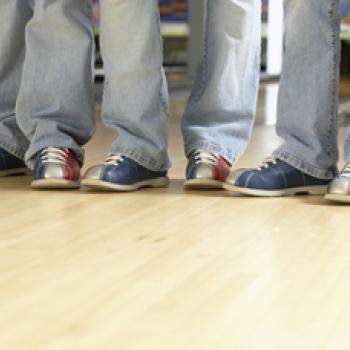Exploring Sets through Math-Related Book Pairs

- Preview |
- Standards |
- Resources & Preparation |
- Instructional Plan |
- Related Resources |
- Comments
Overview
This lesson integrates reading, writing, viewing, and visually representing mathematical ideas while simultaneously strengthening home-school communication. The two math-related books, or the “book pair,” used in the lesson give real-world contexts to the strategy of grouping objects to be counted. The books from the book pair both follow predictable formats that support emerging readers, and students can use these structures as frames for their own writing. After reading each of the books, students explore their school and home environments to find and represent their own examples of sets. In the culminating activity, students create pages for a collaborative class book of sets.
Featured Resources
Stapleless Book: Students select page templates and then design pages that can be printed out, cut and folded into an eight-page book.
Multigenre Mapper: Students use this online tool to create multigenre, multimodal texts that include a drawing and three written texts. They can name the genres for each section, making the tool flexible for multiple writing activities.
From Theory to Practice
Pairing math-related books encourages children to "extend their understandings of each text differently than if only one text had been read" (Short & Harste, 1996, p. 537) and to apply mathematical ideas to the world around them (NCTM Connections Standard, 2000; Whitin & Whitin 2004). In this lesson, two books give students mathematical lenses to view their environment. Involving families gives children further opportunities to talk, write, and draw about mathematical patterns and relationships (NCTM Communication Standard, 2000). Finally, children become authors of their own nonfiction texts, using the formats of the book pairs as guides.
Further Reading
Common Core Standards
This resource has been aligned to the Common Core State Standards for states in which they have been adopted. If a state does not appear in the drop-down, CCSS alignments are forthcoming.
State Standards
This lesson has been aligned to standards in the following states. If a state does not appear in the drop-down, standard alignments are not currently available for that state.
NCTE/IRA National Standards for the English Language Arts
- 1. Students read a wide range of print and nonprint texts to build an understanding of texts, of themselves, and of the cultures of the United States and the world; to acquire new information; to respond to the needs and demands of society and the workplace; and for personal fulfillment. Among these texts are fiction and nonfiction, classic and contemporary works.
- 2. Students read a wide range of literature from many periods in many genres to build an understanding of the many dimensions (e.g., philosophical, ethical, aesthetic) of human experience.
- 11. Students participate as knowledgeable, reflective, creative, and critical members of a variety of literacy communities.
- 12. Students use spoken, written, and visual language to accomplish their own purposes (e.g., for learning, enjoyment, persuasion, and the exchange of information).
Materials and Technology
- One, Two, One Pair! by Bruce McMillan
- What Comes in 2’s, 3’s, and 4’s? by Suzanne Aker
- Other books selected from the provided booklist
Printouts
Websites
Preparation
- Gather the books needed for the lesson from the booklist.
- Make appropriate copies of Pairs Homework Activity Sheet, Sets of 3, 4, 5, 6 Activity Sheet, Suggested Criteria for Assessment: Read-Aloud, and Suggested Criteria for Assessment: Class Book.
- Test the Stapleless Book and Multigenre Mapper on your computers to familiarize yourself with the tools and ensure that you have the Flash plug-in installed. You can download the plug-in from the technical support page.
Student Objectives
Students will
- identify sets of objects in familiar contexts (school and home).
- represent sets of objects with numbers, words, and pictures.
- describe patterns and relationships as shown in repeated addition.
- incorporate numerical, visual, and written descriptions in a revised and published format.
Session One
- Introduce the book One, Two, One Pair! to the children.
- After reading the story, invite the class to respond further by asking the questions below. It is likely that children will spontaneously point to other pairs (on their bodies, in the classroom).
- What did you find interesting about this story?
- What else did you notice?
- What did you find interesting about this story?
- Act out skip counting by 2’s (e.g. using hands, shoes, or eyes). Encourage students to work in pairs, too.
- Allow about 5 minutes for a “pair hunt” around the room and then reassemble.
- Students should record their discoveries individually in a math journal, or as a whole-group shared writing experience.
- Use opportunities throughout the day to add new discoveries, writing the details down in students’ math journals or on the class list.
- When all students are comfortable with finding pairs and using pairs to skip count, pass out the Sets of 2 Handout to be completed outside of the classroom.
- Allow several days for the activity to be completed.
Session Two
- Invite students to share their Sets of 2 discoveries with the class.
- Use their examples to practice skip counting and to pose and solve oral problems. For example, if two students brought in pictures of earrings, ask how many earrings there are all together with two sets or pairs of earrings.
- On a chart, make a class list with picture clues of the sets that were discovered. Post the chart for continued reference.
- Introduce What Comes in 2’s, 3’s and 4’s? Invite students to compare this book with One, Two, One Pair! before reading the second book. Again, invite comments about the various examples during reading.
- Allow students to find examples of sets of 2’s, 3’s and 4’s (and later, 5’s and 6’s) in the room and around the school.
- When students are familiar with finding this range of sets, pass out the Sets of 3’s, 4’s, 5’s and 6’s handout to be completed outside of the classroom.
- Allow several days for the activity to be completed.
Session Three
- Invite students to share their Sets of 3’s, 4’s, 5’s and 6’s with the class.
- Make a chart with some examples of each of the sets, adding picture clues.
- Show both books, the book pair, to students and suggest that the class make their own book of sets.
- As a class, choose a format for the class book.
- Once the format for the class book has been selected, make a planning sheet on chart paper.
- Students create their pages for the books during whole-group or center time. (Some of the above choices lend themselves to having a student team of “editors” sequence the pages in a logical order.)
- Celebrate the completed book(s), and use the students’ book to create story problems.
Extensions
- Use coins to represent sets of 5 and 10.
- In the math center, have a set of cards available that shows even numbers (2 – 20) with a pocket chart. Students can place the numbers in consecutive order (ascending or descending). Have the correct order printed on a sentence strip for self-checking. Invite students to compare the sequences of counting by 2’s and counting by 4’s. Have them share their discoveries at meeting time.
- Have students represent sets and repeated addition on the 100-board (or modified chart), and on a calculator, using the repeat function key (= sign). This can be done traditionally or using an online calculator or Interactive 100 Square.
- Discuss single things that are referred to as pairs (e.g., pants, glasses, scissors). Invite the students to share why those items are called pairs when they are only one item.
- Use the class book of sets to create story problems. For example, “I see 2 cars. How many wheels do I see?” or the reverse: “I see 8 wheels. How many cars do I see?” Practice orally, use the ideas for shared writing, and invite independent writing.
Student Assessment / Reflections
- Oral responses and anecdotal notes from read-aloud and sharing sessions.
- Assessment of student’s work, checking to make sure that the pictures accurately reflect the number of objects in a set and that the children explain their collections (orally or in writing).
- Completion of class book page/individual book.


Add new comment